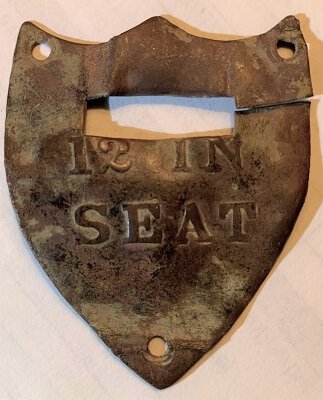Civil War McClellan Pommel Shields
Like so many details of American military horse equipment, these details can be traced to European influences – even to the small small brass decorative fittings. Pommel ornaments or ‘shields’ are a fixture of US military saddles going all the way back to the first Ringgold dragoons saddles (circa 1841-42). A natural solution for reinforcing the mortise holes in the pommels and cantles, subjected to the daily wear and tear of the coat straps, these fittings were used continuously on US cavalry and artillery saddles for a century.
The McClellan series of saddles sported these ornaments as well, with many variations being made during the Civil War. The ‘Pattern of 1859’ equipment was very new, and production had been limited to relatively small orders from a few contractors. Arsenal production of the new equipment in 1860 was very small – St. Louis Arsenal had made a few dozen bridle escutcheons[2], Frankford Arsenal, in Philadelphia, was basically inspecting and accepting deliveries from the local saddlery contractors (850) and made a few metal specification patterns[3], with Allegheny Arsenal just starting to produce the new McClellan set (503 in 1860)[4].
The McClellan series was made in three different sizes – 11″, 11 ½”, 12″. This measurement was the straight-line distance from the point where pommel and cantle meet the sidebar, along the inner edge of the sidebar (see below). A ‘1’ marking corresponded to the 11″ seat, the ‘2’ to the 11 ½” and the ‘3’ to the 12″ seat. Percentage of each seat size in production: 15% of all saddles were to be 11″, 50% were to be 11 ½”, and 35% were to be 12″.

The confusing aspect of this number sizing system is that there are lots of plates that have the tree size clearly embossed in full-text, and this full-text marking was continued for the rest of the lifetime of the McClellan series. How this change came about was a bit mysterious until an article was found in the first issue of the ‘United Service Magazine’[5] – one Capt. Joseph Ash wrote a detailed critique of the horse equipment then being issued, and many heretofore unknown details were revealed. One of great interest here was his observation that ‘numbered plate’ saddles were arsenal production, and full-text size plates were used for contractor produced equipment. Written mid-war, this gives a useful insight to early and mid-war saddles – late war arsenal production changed in some ways, but that’s another story. Whether this division of markings described by Capt. Ash is completely accurate or not is still to be determined, but it makes sense given the variety of shields found on old saddles and dug artifacts.
A small display of numbered shields, showing that stamps were varied in both size and font – apparently whatever was readily available.
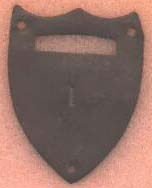 | 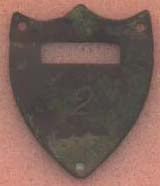 |  |  |
 | 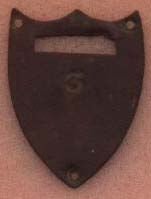 |  |  |
The unusual outlier for the arsenal shields were those found on Allegheny Arsenal saddles. This arsenal used a very specific type of pommel shield for the first few years of the war, bearing the size stamp, the name of the arsenal, and the date of manufacture. Following is a small collection of images of original Allegheny Arsenal pommel plates. I’ve yet to see an ‘1860’ – it’s not known if this marking was used on the 503 saddles made there in 1860. The ‘1861’ is quite common, and there are examples from 1862 and 1863. Changes in the Ordnance Department specifications regarding the manufacture of saddle trees appears to have led to changes that caused these arsenal-specific plates to be dropped. More on this in a later article.
 1860 Allegheny Arsenal [7] |  |  |  |
A small collection of original Allegheny Arsenal pommel shields. Key points of interest are the small, fine, heavily ‘serif’-ed font. The last ‘1’ in ‘1861’ appears to be a slightly larger number, somewhat lower set than the other three. This characteristic is pretty uniform across all ‘1861’ Allegheny plates. Note that the slot for the coat strap is an oval, and not the more common square-ended rectangle. The size numeral is present on all specimens, in the center just above the coat strap slot. The earliest one known to the author was recently shared, and is included in the lineup above – 1860.
Now, this Allegheny plate has been reproduced in various qualities, and here are some examples of reproductions (in the block of images below). In general, most are easily spotted with the exception of one. The rectangular slot is the biggest giveaway for a reproduction. The one on the far right is the ‘dangerous’ one of the lot – as the lettering is close, the slot is correct. The font is not quite the same however, and the stamping of the lettering is much deeper and the die letters leave a heavier, thicker shape that is notable. The alignment of the letters is much more consistent than the originals – the ‘S’ in ‘Arsenal’ is very distinctive on the original arsenal markings. The modern version is also a somewhat heavier gauge brass stock, and the backs will show the impression from the stamping – which usually isn’t noticeable on originals. Fraudulent offerings at places like eBay, for instance, will often have the size stamping below the date, which is never the case with originals. In most of these attempted frauds, the number stamp is significantly larger than the originals used at the arsenal. There is an eBay seller that offers a number of these reproductions made in the last twenty years or so and falsely claims them to be old “Bannerman stock” – occasionally with some tarnishing added for effect. These brass reproductions were originally coated with a thin lacquer, and the fakers rarely get it all removed before they attempt to tarnish/patina the item, which leaves tell-tale bright brass splotches.
Allegheny-marked shields are highly uncommon in non-dug condition, as these arsenal saddles were issued and used up during the war. Any that are found on the loose in better-than-average condition should be examined closely for possible shenanigans.
 |  |  |
On the opposite side of the supply chain, we have those examples of the full-text size embossed plates, most commonly associated with contractor manufactured saddles. Now, with the caveat that even the government arsenals began using these later in the war (1863-5), we’ll show some examples – the variety is much greater with these, which makes them interesting for the collector. The only consistencies for these contractor plates is that they were generally lighter weight brass stock, with lighter embossing than post-war types. This allowed the letters to be quite crisp around the edges, as they were did not deform the brass nearly as much as postwar embossing. I’ll be adding interesting variations to this as they are found.
 | 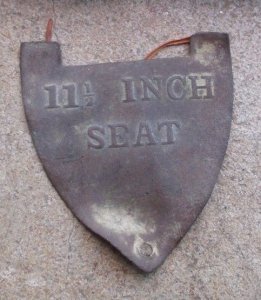 |  |
 | 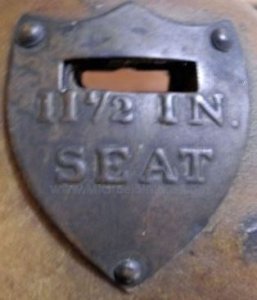 |  1864 Allegheny Arsenal shield[6] 1864 Allegheny Arsenal shield[6] |
A detail commonly seen in some of these plates is the ‘clipped lettering’ as shown in the bottom row of the plates immediately above. These show up for a number of contractors, primarily in the New York/New Jersey area – Demarest saddles commonly show this characteristic.

